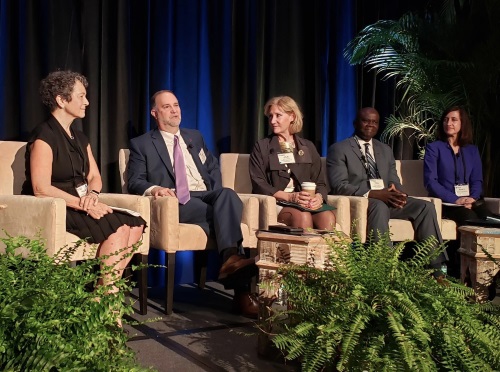Implementing the $1.2 trillion Infrastructure Investment and Jobs Act or IIJA – signed into law in November 2021 – is going to rely heavily on state departments of transportation, according to key U.S. Department of Transportation leaders.
[Above photo by AASHTO]
Katie Thomson, USDOT’s director of bipartisan infrastructure law implementation, noted at the American Association of State Highway and Transportation Officials 2022 Washington Briefing that “AASHTO’s leadership proved absolutely instrumental” to making the IIJA a reality.

“We know this law will only succeed if you succeed: we will succeed together,” she explained. “We are looking to leverage the law’s programs to support larger multimodal projects. We are trying to maximize what we can do today and be transparent about what we cannot do in the face of lack of full funding appropriations.”
Stephanie Pollack, deputy administrator of the Federal Highway Administration, added that USDOT is keenly focused on “outcomes” when it comes to IIJA implementation.
“Making the roads safer for all travelers, making infrastructure more resilient, create good union jobs, and improve supply chain operations,” she said.

Pollack also touched on FHWA’s effort to “broaden” opportunities for state DOTs to support local roads via a focus on “Complete Streets.”
“We know many state DOTs are onboard with ‘Complete Streets,’ which will help us address the clear safety crisis occurring on our roads,” Pollack said. “We know ‘Complete Streets’ will make roads safer for all users, because redefining how we build our road will deliver on that promise of safety for all.”
[Editor’s note: In February 2021, for example, the South Carolina Department of Transportation adopted new “Complete Streets” guidelines to identify and include “walking, bicycling, and transit needs” with the state’s mobility planning process.]
Nuria Fernandez, administrator of the Federal Transit Administration, stressed that while safety remains her agency’s “number one priority” for the transit industry, equity and addressing the impact of climate change are now key parts of the Biden administration’s transportation focus as well.

“The important thing here is we cannot pass up this opportunity to protect the fragile ecosystem we live in,” she explained. “Meanwhile, everyone should have the same access to mobility and to opportunity that transit provides. That’s what we mean when we talk about equity: we must ensure all boats will rise. We must also make sure our priorities – safety, equity, and climate – are everyone’s priorities in transportation.”
Amit Bose, administrator of the Federal Railroad Administration, emphasized that, “repetition is a good thing” when it comes to each modal administration within USDOT making safety, equity, and climate change key strategic goals.

“It reflects our shared commitment to advancing infrastructure that makes a real difference to people and communities – and transportation is central to realizing the president’s vision of a more equitable and safer America primed for economic growth,” he stressed.
“The IIJA offers us the opportunity to build a sustainable rail program and spur efforts to build new regional rail networks,” Bose said. “I know this is just the beginning – look forward to encouraging more and deeper federal and state investment in rail programs.”



